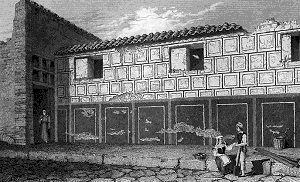Plate XXXVIII - Windows of the atrium
|
Much has been said, and more has been doubted, on the subject of the windows of the ancients. It was not probable that houses, and especially cubiculi, could have existed without the means of excluding the cold, yet, at the same time, admitting light. Even in modern times, however, except in the dwellings of the great, the lighting of a house in Italy or Greece, on a rainy or windy day, is very imperfect, in consequence of the scarcity of glass, or its late introduction as an article of common use. The villa of Arrius Diomedes is said to have had a window the panes of which were divided by lead, just as we find them in old houses in England. |
The thermae had the same divisions of brass, but
these windows of the Tragic Poet of Pompeii are the only
examples at present existing of the manner of opening and
shutting. The accounts remaining of the scarcity or abundance
of glass among the ancients are very contradictory. Vopiscus
accuses Firmus of luxury for having windows of glass in the
time of Aurelian. Caligula, when giving audience to Philo, a
rich Jew of Alexandria, is stated to have attended to nothing
but new-glazing his windows, so that the imperial palace must
have been glazed long before to have required renewing.In
this view two of the iron tramps remain by which wooden
frames were fixed to the wa11, and in those frames the
window, either of glass, linen, or wood, moved backwards and
forwards. If the slider was merely a shutter, which it
appears to have been, it was probably not without a small
hole in the centre, square or circular, glazed or covered
with linen, or even open to admit a small portion of
light.
These windows are six feet six inches above the foot
pavement, so as not to admit the gaze of passengers. The foot
pavement itself is here one foot seven inches higher than the
street or vicus, which is paved with polygons, of which a
quarry was found by the Hon. W. Strangways not far from Torre
dell' Annunziata.
The vicus, without the footpaths, which are each about
three feet nine inches wide, measures only seven feet six
inches in breadth. These alleys could never have been
narrower, according to the old Roman law. «Viai
lateitoudo endo porrectum octo pedem estod, endo amfractom
sedecim». The width of the streets must be eight feet
where straight, but sixteen where they turned. The houses on
each side of these narrow streets were justly called
Vicinales : «Vicinales qui in vico sunt».
The windows are only one foot eleven inches wide, and not
three in height. Within the chambers the opening measured
only two feet six inches, and there was perhaps some
appearance of an internal casernent which opened inwards. The
red panels are four feet seven inches in height. On these the
children have frequently drawn rude figures with a pin or a
nail, and have sometimes written sentences not more delicate
than the figures, as boys are apt to do in our own times. The
word IVCVNDO occurs twice among the names. The windows open
into what is called the library, and two other cells or
cubiculi of the Tragic Poet. The opening on the left
is that which leads to the peristyle of the same house, and
the party wall divides the Poet from the house called the
Fullonica.
